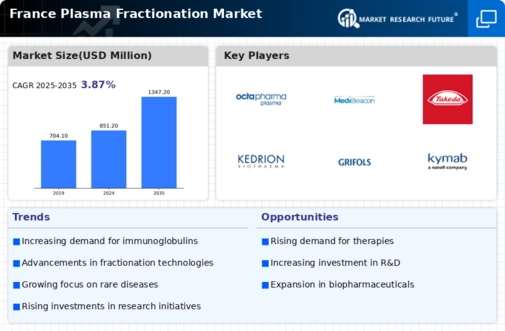Supportive Regulatory Environment
The regulatory landscape in France is becoming increasingly supportive of the plasma fractionation market. Regulatory bodies are implementing streamlined approval processes for plasma-derived products, which may facilitate quicker market entry for new therapies. This supportive environment is likely to encourage innovation and investment in the plasma fractionation sector. In 2025, the French government is expected to continue promoting policies that enhance the development and commercialization of biopharmaceuticals, including plasma-derived therapies. The alignment of regulatory frameworks with industry needs may foster collaboration between stakeholders, ultimately benefiting the plasma fractionation market. As regulations evolve to support advancements in technology and product safety, the market is poised for growth, attracting new players and expanding existing operations.
Advancements in Fractionation Technologies
Technological innovations in plasma fractionation processes are playing a crucial role in shaping the market landscape in France. The introduction of advanced separation techniques, such as chromatography and membrane filtration, has improved the efficiency and yield of plasma-derived products. These advancements not only enhance product quality but also reduce production costs, making therapies more accessible. In 2025, the market for plasma fractionation technologies is anticipated to grow by approximately 15%, driven by these innovations. Furthermore, the integration of automation and artificial intelligence in manufacturing processes is likely to streamline operations, thereby increasing output. As these technologies continue to evolve, they may significantly influence the plasma fractionation market, fostering a competitive environment that encourages further research and development.
Increasing Investment in Biopharmaceuticals
The plasma fractionation market in France is experiencing a surge in investment, particularly in the biopharmaceutical sector. This trend is driven by the growing recognition of plasma-derived therapies for treating various medical conditions. In 2025, the biopharmaceutical industry in France is projected to reach approximately €30 billion, with a significant portion allocated to plasma fractionation technologies. The increasing funding from both public and private sectors is likely to enhance research and development efforts, leading to innovative products and improved production processes. This influx of capital may also facilitate collaborations between academic institutions and industry players, further propelling advancements in the plasma fractionation market. As a result, the overall growth trajectory of the market appears promising, with potential for new therapeutic applications emerging from these investments.
Aging Population and Rising Healthcare Needs
France's demographic shift towards an aging population is significantly impacting the plasma fractionation market. By 2025, it is estimated that over 20% of the French population will be aged 65 and older, leading to increased healthcare demands. This demographic trend is likely to drive the need for plasma-derived therapies, particularly for age-related conditions such as immune deficiencies and bleeding disorders. The healthcare system's focus on providing effective treatments for chronic diseases may further stimulate the plasma fractionation market. Additionally, the rising prevalence of conditions requiring plasma-derived products suggests a growing market potential. As healthcare providers adapt to these demographic changes, the plasma fractionation market is expected to expand, catering to the evolving needs of the population.
Growing Awareness of Plasma-Derived Therapies
There is a notable increase in awareness regarding the benefits of plasma-derived therapies among healthcare professionals and patients in France. This heightened awareness is likely to drive demand for plasma fractionation products, as more individuals seek effective treatment options for various health conditions. Educational initiatives and outreach programs by healthcare organizations are contributing to this trend, emphasizing the importance of plasma therapies in managing chronic diseases. By 2025, the market for plasma-derived therapies is expected to expand, with a projected growth rate of around 10%. This growing recognition of the efficacy and safety of these therapies may lead to increased prescriptions and utilization, thereby positively impacting the plasma fractionation market.
























Leave a Comment